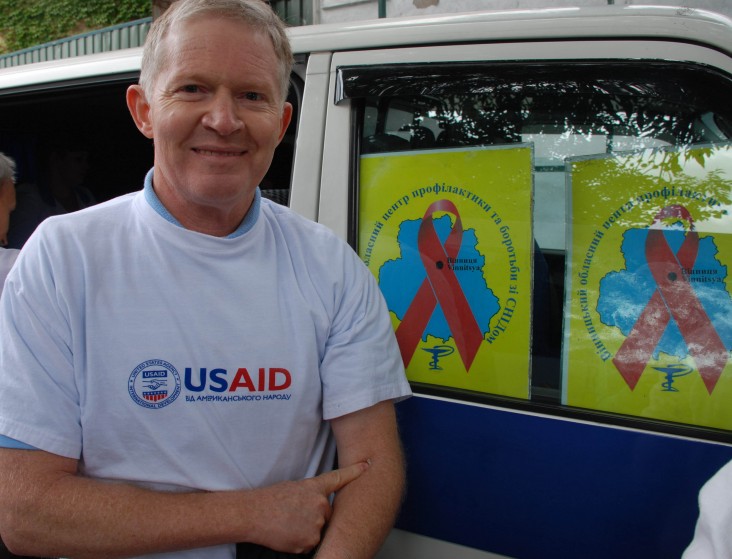
THE CHALLENGE
Ukraine is experiencing one of the most severe HIV/AIDS epidemics in Europe and the former Soviet Union, with an
estimated 210,000 people aged 15 and over living with HIV in 2013. Data suggest that about half of all individuals infected with HIV are unaware of their status and therefore unable to enroll in lifesaving care and treatment and prevent further transmission. While the number of newly registered HIV cases and HIV incidence among people who inject drugs (PWID) in the country has stabilized, HIV transmission to the sexual partners of PWID and remains an area of concern.
HIV/AIDS PARTNERSHIP FRAMEWORK GOALS
- Reduce the level of HIV transmission among people who inject drugs and other most-at-risk populations.
- Improve the quality and cost-effectiveness of HIV prevention, care, and treatment services for most-at-risk populations, particularly people who inject drugs and their sexual partners.
- Strengthen national and local leadership, capacity, policies, and resources to reach national AIDS program objectives.
OVERVIEW
USAID has worked with the Government of Ukraine (GOU), multilateral and international agencies and donors, nongovernmental organizations, and the private sector to accelerate epidemic control and reduce the level of HIV transmission
among key populations since 2001. Under the President’s Emergency Plan for AIDS Relief (PEPFAR), the U.S. Government and the GOU signed a five-year Partnership Framework to establish greater cooperation in countering HIV/AIDS epidemic (2011-2015). The Framework serves as an umbrella for ongoing and expanded HIV/AIDS programming in Ukraine. USAID programs leverage resources from the Global Fund providing technical assistance for improved quality, impact, and sustainability of HIV/AIDS prevention, care, and treatment services aimed at most-at-risk populations and those suffering from TB/HIV co-infection.
OUR PROGRAMS
USAID addresses the challenge of achieving long-term sustainability for a national HIV/AIDS response by working closely with all relevant stakeholders to strengthen health systems at the national and local levels, improving accessibility, quality, and effectiveness of HIV services and epidemic control.
USAID provides support to reduce the transmission of HIV through the promotion and adoption of state-of-the-art comprehensive prevention, care, and treatment services to most-at-risk populations (in particular, people who inject drugs, female sex workers, men who have sex with men, and prisoners); improve access to TB/HIV co-infection services; and increase the availability of medication-assisted therapy (MAT) such as methadone to those affected by the disease. USAID also works to reduce policy, legal, social, and fiscal barriers negatively impacting access to quality HIV services. USAID supports institutionalization and application of international standards for sustained provision of quality services by civil society and government institutions. USAID also supports research and innovation and builds the capacity of health leaders to use data for decision-making.
USAID’s assistance increases the quality of HIV services for vulnerable populations and their partners. It also reduces stigma and discrimination experienced by those seeking HIV and critical health care services. USAID helps to strengthen access to HIV care and treatment for individuals in prison detention and link them to local HIV/AIDS services in civilian healthcare sector upon their release. Furthermore, USAID works closely with law enforcement, drug control, and prison authorities to raise awareness about HIV/AIDS and advocate for comprehensive HIV services for injection drug users. Improved access to HIV/AIDS and TB diagnostics and medication at public health facilities is an additional area in which USAID supports the Government of Ukraine.
PROGRAM HIGHLIGHTS
The United States Government PEPFAR Program supported by USAID has demonstrated results in preventing the spread of HIV/AIDS in Ukraine. USAID’s HIV/AIDS programs, in partnership with the GoU, Global Fund, produced an impressive reduction in the growth rate of HIV infection from 27.4 percent in 2004 to 1.2 percent in 2010 in the nine regions assisted by USAID interventions. The proportion of young people aged 15-24 years among newly reported cases nationally decreased from 20% in 2006 to 7% in 2013.
USAID-supported PEPFAR Program achievements include:
- Establishment of an implementation science framework and creation of a national research agenda for evidence-based interventions;
- Implementation of an innovative client/vendor service purchasing model to strengthen local NGOs and public institutions to serve as long term sources of state-of-the-art technical and organizational capacity building;
- Increased commitment by national drug control policy and drug dependence treatment partners to integrate HIV-related services into the drug dependence treatment system and penitentiary system;
- Piloting quality improvement models at health facilities in selected oblasts focused on HIV counseling and testing;
- Strengthened capacity of civil society in 8 participating regions and on the national level to provide HIV services;
- Development and approval of the new Law on the Implementation of the Global Fund grants in Ukraine in 2012. This law removed regulatory, tax and administrative barriers for Ukrainian organizations, including government agencies, to receive and manage Global Fund grants including HIV/TB current Grant (2014-2017);
- Approval of the Law on the National HIV/AIDS Program (2014-2018) that will allow continue funding critical HIV prevention and care services after the completion of the new 3-year Global Fund HIV-TB grant in 2017;
- Development of the curriculum on managing HIV services by family doctors that included an HIV stigma and discrimination component.







Comment
Make a general inquiry or suggest an improvement.